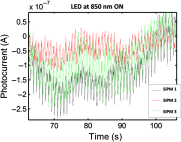Characterization of a fiber-less, multichannel optical probe for continuous wave functional near-infrared spectroscopy based on silicon photomultipliers detectors: in-vivo assessment of primary sensorimotor response
- PMID: 28983487
- PMCID: PMC5615232
- DOI: 10.1117/1.NPh.4.3.035002
Characterization of a fiber-less, multichannel optical probe for continuous wave functional near-infrared spectroscopy based on silicon photomultipliers detectors: in-vivo assessment of primary sensorimotor response
Abstract
We report development, testing, and in vivo characterization of a multichannel optical probe for continuous wave (CW) functional near-infrared spectroscopy (fNIRS) that relies on silicon photomultipliers (SiPMs) detectors. SiPMs are cheap, low voltage, and robust semiconductor light detectors with performances analogous to photomultiplier tubes (PMTs). In contrast with PMTs, SiPMs allow direct contact with the head and transfer of the analog signals through thin cables greatly increasing the system flexibility avoiding optical fibers. The coupling of SiPMs and light-emitting diodes (LEDs) made the optical probe lightweight and robust against motion artifacts. After characterization of SiPM performances, which was proven to provide a noise equivalent power below 3 fW, the apparatus was compared through an in vivo experiment to a commercial system relying on laser diodes, PMTs, and optical fibers for light probing and detection. The optical probes were located over the primary sensorimotor cortex and the similarities between the hemodynamic responses to the contralateral motor task were assessed. When compared to other state-of-the-art wearable fNIRS systems, where photodiode detectors are employed, the single photon sensitivity and dynamic range of SiPMs can fully exploit the long and variable interoptode distances needed for correct estimation of brain hemodynamics using CW-fNIRS.
Keywords: continuous wave functional near-infrared spectroscopy; primary sensorimotor response; silicon photomultipliers; wearable neuroimaging.
Figures







References
LinkOut - more resources
Full Text Sources
Other Literature Sources
Miscellaneous

